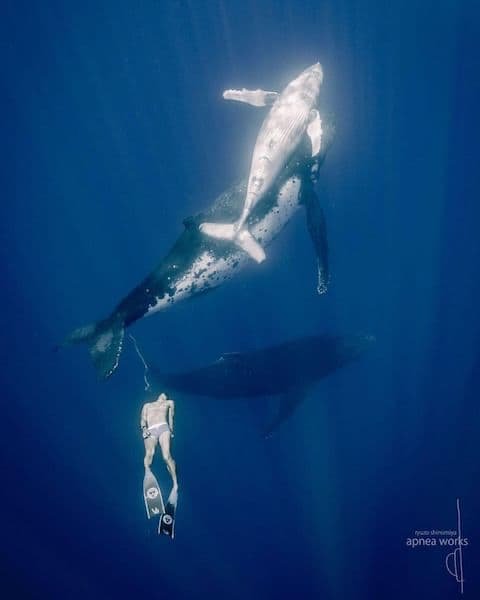
 Olivia Møller
Freediver - Activist - Explorer
Olivia Møller
Freediver - Activist - Explorer

 Olivia Møller
Freediver - Activist - Explorer
Olivia Møller
Freediver - Activist - Explorer
Whales, the giants of the ocean, have long fascinated humans with their sheer size and majestic presence. Yet, beyond their charismatic appeal, these marine mammals play an incredibly vital role in the Earth's ecosystems, one that extends far beyond the boundaries of the sea. Whales are not just magnificent creatures; they are also powerful carbon sequesters, with their actions influencing the planet's carbon balance in profound ways. Let's explore the world of whales and their crucial role in carbon sequestration.
Whales, despite their imposing size, are gentle giants of the ocean, and they serve as key players in the Earth's carbon cycle. Their contribution to carbon sequestration can be attributed to several unique factors:
Whale Falls: Carbon Sinks of the Deep
When whales die, their massive bodies often sink to the ocean floor, creating what scientists refer to as "whale falls." These carcasses can become bountiful sources of sustenance for deep-sea organisms, and they also play a critical role in carbon sequestration. As Dr. Asha de Vos, a marine biologist, notes, "Whale falls are like underwater oases of life. They provide both sustenance and carbon storage opportunities for organisms in the deep sea."
The organic matter from whale falls provides sustenance for a variety of organisms, including specialized bacteria that consume the bones and tissue. This consumption process sequesters carbon, trapping it in the bones and sediment on the ocean floor for extended periods.
Enhancing Phytoplankton Growth: A Ripple Effect
Whales are known to enhance the growth of phytoplankton, microscopic marine plants that form the foundation of the ocean food web. As these whales move through the ocean, they release nutrient-rich fecal plumes, which contain essential nutrients like nitrogen and iron. These nutrients act as fertilizers for phytoplankton, promoting their growth.
Dr. Joe Roman, a conservation biologist, emphasizes the importance of this process: "Whales act as nutrient recyclers. Their activities stimulate phytoplankton growth, which in turn captures carbon dioxide through photosynthesis. This contributes to the ocean's ability to absorb carbon from the atmosphere.

The connection between whales and climate change is more intricate than meets the eye. While whales sequester carbon, their role extends to mitigating the effects of climate change in several ways:
Carbon Sequestration Potential
A study published in the journal "Frontiers in Ecology and the Environment" estimates that a single great whale, such as the blue whale, can sequester approximately 33 tons of carbon dioxide during its lifetime. When these massive creatures die and their carbon-rich remains sink to the ocean floor, this carbon is effectively removed from the atmosphere, contributing to climate change mitigation.
Maintaining Ecosystem Health
Whales play a crucial role in maintaining the health and balance of marine ecosystems. As apex predators, they regulate the populations of their prey, such as krill and small fish. Dr. Sylvia Earle, a renowned oceanographer, explains, "When whales thrive, they help maintain the delicate balance of marine ecosystems. This balance ensures that carbon sequestration processes, including phytoplankton growth, can continue efficiently."

While whales are powerful carbon sequesters, they face numerous threats that jeopardize their populations and, consequently, their carbon sequestration potential:
Commercial Whaling
Historically, whales were hunted extensively for their blubber, oil, and meat. Commercial whaling severely depleted whale populations, pushing many species to the brink of extinction. Although the International Whaling Commission (IWC) imposed a moratorium on commercial whaling in 1986, some countries continue to engage in whaling for purported scientific purposes.
Dr. James Hanski, a marine conservationist, highlights the issue: "Commercial whaling poses a significant threat to whale populations, particularly in the case of species like the minke whale. This not only disrupts their vital ecological roles but also hinders their ability to sequester carbon effectively."
Entanglement and Collisions
Whales are susceptible to entanglement in fishing gear, such as nets and lines, as well as collisions with vessels. These incidents can lead to injury or death, further impacting their populations.
Dr. Kate Stafford, an oceanographer, underscores this concern: "Accidental entanglement and vessel collisions are ongoing threats to whales. These incidents not only harm individual whales but also disrupt their ecological functions in the marine environment."

Recognizing the vital role of whales in carbon sequestration and ecosystem health, conservationists, scientists, and organizations worldwide are working diligently to protect and restore whale populations:
Global Moratorium on Commercial Whaling
The IWC's global moratorium on commercial whaling, established in 1986, remains a pivotal step in safeguarding whales. While challenges persist, this international agreement has contributed to the recovery of some whale species.
Marine Protected Areas (MPAs)
The establishment of marine protected areas, where hunting and harmful human activities are restricted or prohibited, provides safe havens for whales. MPAs not only protect whales directly but also support the overall health of marine ecosystems.
Advocacy and Education
Public awareness campaigns, advocacy efforts, and educational programs are crucial components of whale conservation. Dr. Asha de Vos emphasizes the importance of public engagement: "By raising awareness about the significance of whales and their role in carbon sequestration, we can garner support for conservation measures that protect these magnificent creatures."

The future of whales and their role in carbon sequestration is intrinsically linked to our collective actions as stewards of the planet:
Climate Change Mitigation
As climate change poses an increasing threat to marine ecosystems, mitigating climate change remains vital to the preservation of whales and their carbon sequestration potential. Transitioning to renewable energy sources, reducing greenhouse gas emissions, and protecting critical whale habitats are essential steps.
Sustainable Practices
Promoting sustainable fishing practices and reducing the impact of marine pollution can help mitigate threats to whales. Dr. Sylvia Earle emphasizes the importance of sustainable choices: "Our daily decisions, such as choosing sustainable seafood and reducing plastic waste, can have a positive impact on the health of the oceans and, by extension, the well-being of whales."

Whales, as ocean giants, are not just symbols of the sea's grandeur but also champions of carbon sequestration. Their influence on marine ecosystems and the carbon cycle underscores their importance in addressing climate change. As we strive to protect and restore whale populations, we must recognize that the conservation of these magnificent creatures is intricately tied to the health of our planet and the mitigation of climate change. By safeguarding whales, we safeguard our future.